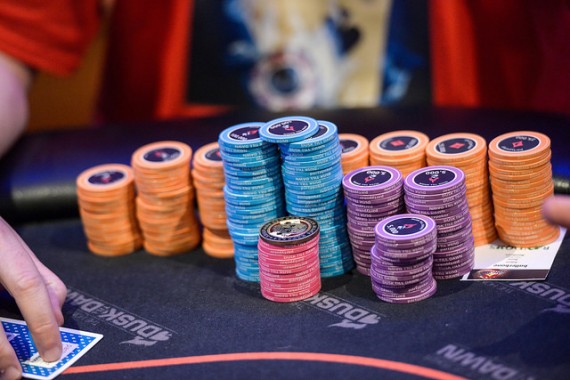by Matthew Pitt
My sister was always the one who was careful with her money when we were growing up. She was the one who had an ever-growing savings account balance while I had pocketfuls of discarded sweet wrappers and more magazines under my bed than WH Smiths had on their shelves.
I have to admit to having endured some serious money issues during my early 20s, but that all changed when I discovered poker and poker bankroll management in particular. Despite having been frivolous with money in my past, I can say with great pride that I have never gone broke , even if I have suffered some horrific downswings in my time.
The main reason for me never busting in poker is that I follow strict bankroll management, possibly too strict if I think about it, yet it is a practice that every poker players from $0.01/$0.02 stakes up to $10,000 buy-in tournaments should follow. Many don’t, but they should.
What is poker bankroll management?
As the name suggests, bankroll management is the management of your bankroll; this is the amount of money you have available to play poker. It is money that you are prepared to lose, that is not needed for any other expense in your life.
If you think that you have a $1,000 bankroll but you need $600 of that to pay for little Johnny’s school skiing trip next month you have a $400 bankroll. Be honest with yourself, never gamble with money that you cannot afford to lose. Even the most elite poker players in the world go on long losing stretches, yet these players can still play their usual stakes because they have built a financial cushion to help soften the blow. They follow bankroll management.
To wrap up what bankroll management is in a sentence or two, I would say bankroll management is allowing the money you have available for poker dictate the stakes you play for and not the other way around.
Why is poker bankroll management so important?
I’ve already mentioned that even the best poker players on the planet can go on long losing stretches, sometimes tens of thousands of cash game hands or hundreds of tournaments. A few years ago, I was playing a lot of 180-man turbo tournaments where I was a long-term winning player. While I was never going to get rich from them, I was making money playing them until one day no matter what I did was wrong. I couldn’t win to save my life. A long story made short; I went on a downswing that spanned 1,200 games and cost me around 150 buy-ins.
It stung, yet I was able to continue playing because I am a bankroll nit and had a large enough poker bankroll behind me to allow me to continue playing. The downswing turned around eventually, and I resumed the slow and often painful task of rebuilding my decimated bankroll.
Another reason for having a decent bankroll behind you is that it allows you to play your A-game with more ease. Having a $50 bankroll and playing in a $0.25/$0.50 game where you buy in for $50 means you have one shot and one shot only. Inevitably, you’ll play a more timid style of poker where you don’t take lines that yield the most value because you’ll be scared of losing. Then you get 
 , get your stack in versus
, get your stack in versus 
 and lose your entire bankroll when a
and lose your entire bankroll when a  lands on the river, taking you out of the game. Having several buy-ins behind you would allow you to keep playing, absorb those inevitable losses and try to win your money back.
lands on the river, taking you out of the game. Having several buy-ins behind you would allow you to keep playing, absorb those inevitable losses and try to win your money back.

How big should your poker bankroll be?
The answer to this question, like many in poker, is it depends. Everyone is different, which is why this great game of ours is exactly that, great. When deciding what size your bankroll should be, make the following considerations:
- Are you willing to move down in stakes if you hit a significant losing stretch?
- Do you want to take a more risky approach to try and move up in stakes faster?
- If you somehow lost all of your bankroll would you be able to afford to replenish it?
- Does your game and format of choice have high variance?
Some games have more variance than others and, therefore, require a larger bankroll. Six-Max Pot Limit Omaha, for example, needs a larger bankroll than full-ring no limit Hold’em due to the nature of the game.
I’ve created a table below for some cash games and tournaments – the games I play mostly – as a guide to what a poker bankroll’s size should be. The information is a mixture of data found in books, poker forums and training videos I’ve seen over the years, plus some of my recommendations.
For cash games, buy-ins refer to the maximum you can buy into a game. If the stakes are $0.25/$0.50, and you can buy in for $50, then one buy-in is $50. For tournaments, if a tournament costs $11 ($10+$1) then $11 is one buy-in.
| Game | Minimum | Medium | Cautious |
|---|---|---|---|
| No limit Hold’em 6-Max cash games | 30 buy-ins | 50 buy-ins | 100 buy-ins |
| No limit Hold’em Full Ring cash games | 25 | 40 | 75 |
| Pot limit Omaha 6-Max cash games | 50 | 100 | 150 |
| Pot limit Omaha Full Ring cash games | 30 | 50 | 100 |
| No limit Hold’em Full Ring SNG | 30 | 50 | 100 |
| No limit Hold’em Multi-Table Tournaments | 100 | 200 | 500 |
| No limit Hold’em Multi-table Tournamenrs (2K+ players) | 200 | 400 | 600 |
For multi-table tournaments, I follow a system that works on an average buy-in system. Say my bankroll at the time is $1,000, according to the table I should only play tournaments with a maximum buy-in of $10. However, I’ll sometimes play a $50 buy-in but then offset the difference by playing a few $1, $2 or $5 tournaments. When calculated at the end of the week or month (total cost of buy-ins divided by the number of tournaments played) my average buy-in will fit into my bankroll constraints as snug as a dog in front of the fire on Christmas morning.The numbers may seem excessively large if you’re not used to following bankroll management or have run so well in the early stage of your career that you’ve never seen a downswing – lucky you! – but I fall somewhere in the middle of Minimum and Medium and have never gone broke.
Play around with the figures, look at your personal circumstances and come up with a figure that suits you. I play better knowing I have a large bankroll behind me; you may play better if the risk of going broke increases. Feel free to share your bankroll recommendations in the comments box below or via our social media channels.
Tagged with: bankroll management • poker strategy


One Response to “A Guide to Poker Bankroll Management”
Comments are closed.